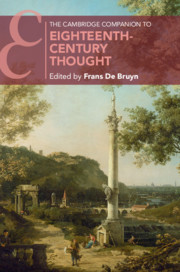27 results
Chapter 16 - Alexander of Aphrodisias on Concepts
-
-
- Book:
- Conceptualising Concepts in Greek Philosophy
- Published online:
- 25 April 2024
- Print publication:
- 02 May 2024, pp 368-383
-
- Chapter
- Export citation
Chapter 3 - Clarification and Analysis in the Tractatus
-
-
- Book:
- Wittgenstein's <I>Tractatus Logico-Philosophicus</I>
- Published online:
- 07 March 2024
- Print publication:
- 14 March 2024, pp 50-68
-
- Chapter
- Export citation
4 - From Proto-pragmatics to Pragmatics
-
- Book:
- Pragmatics and Emotion
- Published online:
- 13 December 2023
- Print publication:
- 21 December 2023, pp 52-71
-
- Chapter
- Export citation
Introduction
-
- Book:
- Freedom of Religion or Belief in the European Convention on Human Rights
- Published online:
- 02 December 2023
- Print publication:
- 23 November 2023, pp 1-10
-
- Chapter
- Export citation
Introduction
-
- Book:
- The Literary Criticism of Samuel Johnson
- Published online:
- 07 September 2023
- Print publication:
- 21 September 2023, pp 1-14
-
- Chapter
- Export citation
Chapter 5 - Shakespeare, Johnson and Philosophy
- from Part III - Johnson, Dramatic Poetry and Thinking
-
- Book:
- The Literary Criticism of Samuel Johnson
- Published online:
- 07 September 2023
- Print publication:
- 21 September 2023, pp 93-110
-
- Chapter
- Export citation

The Literary Criticism of Samuel Johnson
- Forms of Artistry and Thought
-
- Published online:
- 07 September 2023
- Print publication:
- 21 September 2023
A Neo-Searlean Theory of Intentionality
-
- Journal:
- Canadian Journal of Philosophy / Volume 51 / Issue 7 / October 2021
- Published online by Cambridge University Press:
- 14 March 2022, pp. 475-495
-
- Article
-
- You have access
- Open access
- HTML
- Export citation
19 - Science of Mind
- from Part III - Problems and Controversies
-
-
- Book:
- The Cambridge History of Philosophy of the Scientific Revolution
- Published online:
- 14 January 2022
- Print publication:
- 06 January 2022, pp 350-368
-
- Chapter
- Export citation
3 - Spinoza on the Metaphysics of Thought and Extension
-
-
- Book:
- The Cambridge Companion to Spinoza
- Published online:
- 14 October 2021
- Print publication:
- 28 October 2021, pp 113-140
-
- Chapter
- Export citation
Chapter 4 - Emotions and Value
-
- Book:
- Moral Responsibility and the Psychopath
- Published online:
- 27 August 2021
- Print publication:
- 16 September 2021, pp 98-131
-
- Chapter
- Export citation

The Cambridge Companion to Eighteenth-Century Thought
-
- Published online:
- 15 June 2021
- Print publication:
- 20 May 2021
4 - Aristotelian Choice
-
- Book:
- Aristotle on Thought and Feeling
- Published online:
- 08 January 2021
- Print publication:
- 07 January 2021, pp 65-80
-
- Chapter
- Export citation
Introduction
-
- Book:
- Aristotle on Thought and Feeling
- Published online:
- 08 January 2021
- Print publication:
- 07 January 2021, pp 1-12
-
- Chapter
- Export citation
The Role of Concepts in Fixing Language
-
- Journal:
- Canadian Journal of Philosophy / Volume 50 / Issue 5 / July 2020
- Published online by Cambridge University Press:
- 24 June 2020, pp. 555-565
-
- Article
- Export citation
21 - The Neuroscience of Imaginative Thought: An Integrative Framework
- from Part III - Intentionality-Based Forms of the Imagination
-
-
- Book:
- The Cambridge Handbook of the Imagination
- Published online:
- 26 May 2020
- Print publication:
- 18 June 2020, pp 332-353
-
- Chapter
- Export citation
1 - A Brief Outline of “Standard” Conceptual Metaphor Theory and Some Outstanding Issues
-
- Book:
- Extended Conceptual Metaphor Theory
- Published online:
- 02 April 2020
- Print publication:
- 23 April 2020, pp 1-21
-
- Chapter
- Export citation
1 - Background and Scope
-
- Book:
- Cognitive Discourse Analysis
- Published online:
- 23 January 2020
- Print publication:
- 13 February 2020, pp 7-31
-
- Chapter
- Export citation
Chapter 4 - Thinking before Theory
-
- Book:
- Arendt on the Political
- Published online:
- 15 October 2019
- Print publication:
- 24 October 2019, pp 84-107
-
- Chapter
- Export citation
Chapter 4 - Conceptual Metaphors for Mind, Intention, and Self in Homer
-
- Book:
- Metaphor in Homer
- Published online:
- 29 July 2019
- Print publication:
- 01 August 2019, pp 165-200
-
- Chapter
- Export citation



